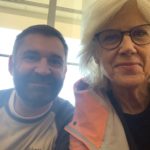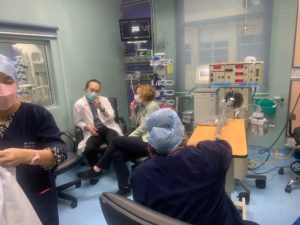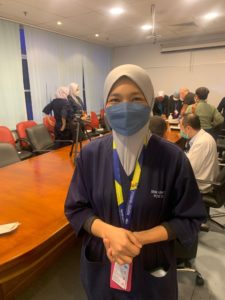Published January 4, 2023
Updated March 6, 2023
Written by Lee Koch, Director of Corporate and Foundation Relations at Children’s HeartLink

The word empowerment comes to mind when I reflect on my very first trip with Children’s HeartLink. I participated in the continuation and growth of a Children’s HeartLink partnership, of a medical community per se, coming together to help save the lives of children with heart disease. A partnership and relationship that is funded by the generosity of so many people, whether with time, talents, expertise or donations.
In my role, as director of corporate and foundation relations, I work closely with groups like Medtronic Foundation, Boston Scientific and Edwards Lifesciences Foundation on funding Children’s HeartLink’s work, which expands access to health care, specifically heart care. I also seek new partnerships with corporations and foundations whose environmental, social and governance goals align with our work to decrease health disparities in low- and middle-income countries.
In November 2022, I traveled with Andreas Tsakistos, Country Director at Children’s HeartLink, to Kuala Lumpur, Malaysia. A country where Edwards Lifesciences Foundation has helped to fund some of our work. On our way to Children’s HeartLink Center of Excellence Institut Jantung Negara (National Heart Institute) we met up with the medical volunteer team from Birmingham Children’s Hospital, England. This was going to be the first in-person training visit since before the pandemic.
A medical community with one goal
Over the course of the six-day visit, I watched the work Children’s HeartLink is doing first-hand. I saw the interactions between the medical team from Birmingham Children’s Hospital and the Institut Jantung Negara (National Heart Institute) team. I was struck by the trust and respect that enabled a connection that resulted in training on a very deep level. There was no question that was too primary, no reflection or problem too rudimentary. These two medical teams, from very diverse cultures and environments, have formed a medical community based on trust and respect.
The two teams participated in lectures and worked together at the bedside to provide the best possible care for children born with heart disease in the Pediatric Cardiac Intensive Care Unit. These professionals are empowering each other to grow and learn, and ultimately give children with heart disease the opportunity to live a full and rich life. All children deserve this.
The heart disease numbers only tell part of the story
Upon preparing for my trip with Children’s HeartLink, I knew the numbers. I knew 9 in 10 children born with congenital heart disease lack access to high quality heart care. I knew Children’s HeartLink had helped partner hospitals serve 120,000 children in 2022. But, what I didn’t realize is those numbers only tell part of the story.

I knew the number one cause of death from non-communicable disease for people under 30 is congenital heart disease.
I didn’t know that every single one of the 20 cribs in the Pediatric Cardiac Intensive Care Unit was full. That while 20 babies receive lifesaving care and surgery there are nearly 600 babies on the waiting list. Nearly 600 families waiting for their child to receive heart care that they desperately need to survive and thrive.
I knew every five minutes ten children are born with heart defects and nine of them lack access to the specialized care they need to thrive.
I didn’t know those nine children could have received the heart care they needed to lead vibrant full lives. That if every child born with a heart defect receives the care they need and deserve, the sky is the limit. Children with heart disease can become Olympians like Shaun White. He became a five-time Olympian after his heart surgery for Tetralogy of Fallot, a rare and complex heart defect.

I knew half of babies born with significant heart defects will die in infancy or childhood.
I didn’t know that they don’t have to die. The earlier babies receive the specialized care they need for their heart defect, the greater their chances are of not only living but thriving.
I knew Children’s HeartLink had 16 medical volunteer teams and 19 partner hospitals as of my travel in November of 2022.
I didn’t know the depth and breadth of the relationships that were formed between medical volunteers and partner hospital teams. That these relationships in the medical community are mutually beneficial, they’re sustainable and they serve the greater good.
A commitment to helping each other and the children in need of access to high quality heart care

In my time with Children’s HeartLink, I’ve seen the difference being made. I’ve heard my colleagues share virtual training successes, I’ve heard about the children’s lives impacted and I’ve heard about the impact we can have at our two new partner sites in Bangladesh and Brazil, National Heart Foundation Hospital and Research Institute and Recife: Real Hospital Português, respectively. I’ve even shared these successes with our funders.

When I traveled to Malaysia, I witnessed first-hand the difference Children’s HeartLink is making on the ground. I witnessed the connection that’s formed between medical volunteer teams and the medical staff at partner hospitals. I witnessed the medical community learning with and from each other. I witnessed the teams sharing vital, everyday life-saving information about how to care for children with heart disease. I witnessed the teams discuss care at the babies’ bedsides. I witnessed babies begin to flourish once more. I witnessed the commitment of these medical professionals to provide the highest quality of care for their patients. I witnessed long-term bonds being formed.
The conclusion of the training visit will not be the end of the partnership. These teams will call upon each other for guidance and support for many months and years ahead.
Partnerships demand the spirit or progress
Many companies and foundations who choose to partner with Children’s HeartLink do so because they believe in the Children’s HeartLink mission: we save lives by transforming heart care in underserved parts of the world. They believe in the sustainable model that brings high quality heart care to children and helps to train other pediatric cardiac care specialists in the region. They also do so because medical teams rely on successful partnerships like Edwards Lifesciences Foundation to help them in screening, diagnosing and treating children with heart disease. If you or your organization might be interested in furthering partnering together with Children’s HeartLink, please feel free to reach out me. I always look forward to making connections and having conversations!
Reflections from Lee Koch, Director of Corporate and Foundation Relations at Children’s HeartLink, after her first international trip with Children’s HeartLink to a Children’s HeartLink Center of Excellence hospital in Malaysia.
If you would like to support the work happening in underserved parts of the world, donate to Children’s HeartLink today.
